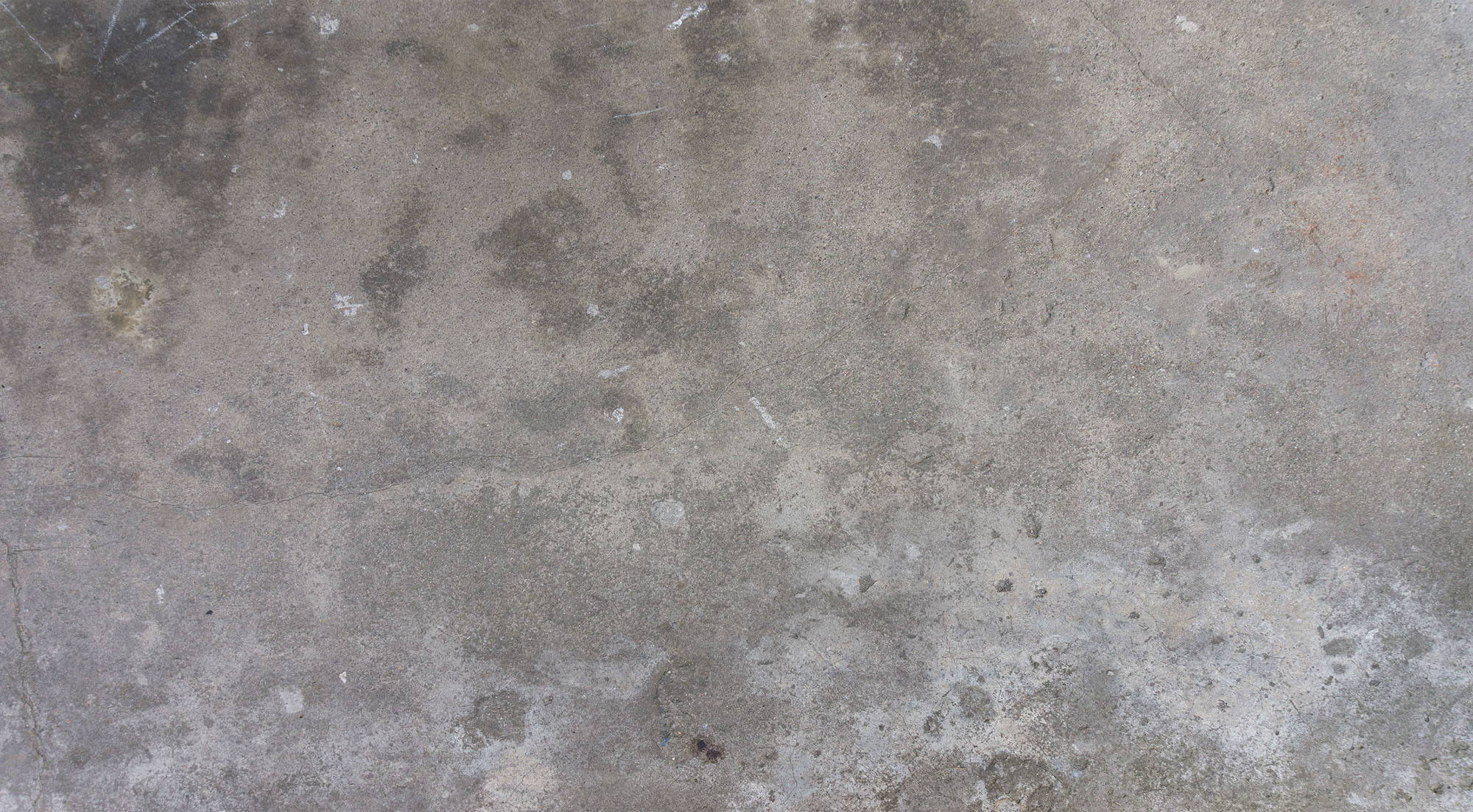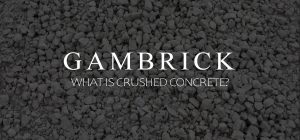
Why Does Concrete Turn Black?
There are a few reasons why concrete turns black. The biggest we see is inconsistency with the ingredients used and their ratios. When you combine batches of concrete that were mixed differently, black patches can form. Another very common reason is moisture. Batches with different moisture levels may not cure evenly which can also result in black spots. Calcium chloride, variations in the cement’s alkali content, additives, and workmanship are even more potential causes. Water damage or de-icing salts can also be to blame. Fortunately, concrete discoloration can usually be cleaned with an acid mixture.
Concrete can change color for a variety of reasons, some can be fixed after the concrete has cured, and some can’t. So it’s important to get your concrete mix ratio right before pouring your slab.
If your concrete turns black, those areas of concrete can get hot because dark colors absorb more heat than light colors. This is hard to fix once the slab is poured if your ingredient ratios are off.
Concrete is a fantastic material that’s used around the world to build everything from large structures like dams and bridges to residential sidewalks, driveways and patios. One of the best features of using concrete is how beautiful it looks without any additional finish work.
However, you have to get the concrete mix ratio just right or it can start to change color over time.
There are plenty of options for adding color, texture and shapes. But the beauty of working with concrete is that it doesn’t need anything of those additional things, but it’s prone to discoloration if your not careful.

What Causes Concrete Discoloration?
There are a lot of potential causes for concrete discoloration and black spots. Finding out which one is the cause after discoloration occurs is very hard to do and often times impossible. And honestly, at that point it really doesn’t matter what the cause was. The black spots are there and you have to deal with it as best you can.
The best thing you can do is understand all the potential causes and prevent them with your new work. Prevention is by far the best way to deal with the issue. Once black spots start happening it’s too late to fix the cause. All you can do now is clean it up.
Luckily the biggest cause of discoloration are the ingredients and improper mixing. There’s no reason you should get black spots as long as you mix the concrete properly, use approved ingredients in the proper ratios and use the correct amount of water. Also mix your concrete thoroughly and evenly between batches.
Inconsistent Mixing
Concrete is generally left it’s natural color without any additional artificial coloring. It’s typically Portland cement, sand, and stone aggregate mixed with water. The ratio of ingredients will vary based on the type of concrete your making. Water is typically 3 quarts per 80 lb bag of concrete. Sometimes additional additives are used to give the mix special features like fast setting, flexibility or increased strength which can also effect the color.
During the curing process, the mix can take on different colors depending on the ingredients used, their ratios and the water content. Water being a major concern in terms of color. If two different batches are used for the same job and one batch has more water, the color will vary. The wetter batch will cure at a different speed than the dryer one which will effect the color.
Consistency in the amount of water used is super important but so are the ingredients. The ratios used and the ingredients themselves need to match from batch to batch. Any variation can effect the color.
Different Type Of Cement
Cement is the active ingredient in concrete. Sand and aggregate add strength but it’s the cement that mixes with water and hardens. A chemical reaction occurs when cement gets wet which is called curing. The concrete dries and hardens over a period of 28 days. When two different types of cement are used to make concrete, it can cause major discoloration. Fortunately, this is something that you can control.
Remember that when you work with concrete, consistency is the key. Most discoloration happens because of mistakes made with the ratios, water, ingredients or other inconsistencies. The good news is that all of these things are avoidable.
Cement Replacements
The most common cement replacements are Fly Ash and Slag.
Fly Ash is a byproduct of coal power plants. It’s usually mixed with about 20% Portland cement and not used all on it’s own. Depending on the type of fly ash you use and the exact ratio, it can cause concrete to change color. It won’t usually cause the concrete to turn black but it can. It’s more common for the concrete to turn a brownish color.
This is another area where consistency is very important. If your using fly ash, make sure the amounts you use and the type are exactly the same from batch to batch. And don’t use a fly ash batch with a standard mix. You could end up with all sorts of weird colors.
Slag is a byproduct of refining iron and steel. It has many of the same properties found in cement, which makes it an effective replacement. Slag concrete tends to have a lighter color than usual, which makes discoloration even more noticeable.
All the same issues effect slag concrete just as they do standard mixes. Ingredients, water levels and ratios should all match from batch to batch. Consistency is very important.
Cement replacement aren’t more prone to discoloration and black spot than regular concrete, but they add another variable. If you plan on using them, make sure your paying attention to your mix. Any variation can lead to black spot.
Calcium Chloride
Calcium chloride is a big cause of black spots and other discolorations.
It’s a type of de-icing salt that is often used over concrete. While it’s very good for getting rid of snow and ice, it’s also very bad for your concrete.
The calcium found in the salt can penetrate into the concrete’s pores and interact with the mineral found within the concrete. These interactions can weaken the concrete and change it’s color. Salts are a big problem with concrete. It’s important to wash them off after you use them, and as soon as it’s safe. Don’t wash them off if it’s cold enough for the water to freeze.
De-icing Salts
Another problem with de-icing salts are the oils attached to the salt during processing. These oils can seep into the concrete and cause discoloration and black spots.
Like with calcium chloride, the best thing to do to protect your concrete is to clean them off when you don’t need them. Don’t let salts sit on top of your concrete for too long.
Clean the concrete off with a power washer or scrub brush when the Winter season is over to remove all the leftover oils and salt residues.
Water Damage
Water is a big cause of black spots and discoloration. If water is allowed to drip or collect on the surface, it can discolor it and cause black spots.
This isn’t because of the water but more so what’s in it. Water carries with it salts, chemicals, oils and other particles. As the concrete absorbs the water, all those elements get deposited inside the concrete. When they build up in one place over time, discoloration and black spots can form.
This is a very common issue with leaky gutters. Water from the gutters drips onto the same area of concrete and eventually leaves black marks. This is dirt and materials inside the water, from the gutters and roof, depositing into the concrete where it falls.
Luckily water damage is an easy fix. Make sure dirty water can’t drop or pool onto your concrete.I’m not talking about rain water. This is commonly due to a leaky pipe, gutter or drain.
Over Finishing
Once the concrete is poured, it needs to be finished. Typically this involves using a trowel the smooth the concrete surface. In the construction business this is referred to as a trowel finish.
While finishing your concrete, it can be tempting to try and make it super smooth. However, over working the concrete can pull water from deeper in the slab to the surface. This can lead to damage including discoloration and black spots. This is known as trowel burn.
Concrete that’s been over troweled reduces the cement-water ratio which may result in dark discoloration. Concrete surfaces that are troweled too early can actually have the opposite effect. The increased water-cement ratio at the surface lightens the concrete’s color.
Metal fragments from the trowel can also be embedded in the surface of the concrete when you trowel too hard or too long. This can eventually cause black spots as the metal interacts with other chemicals.
The best way to avoid this is to hire a professional. There’s a lot of stress at the end of a concrete job because the finish needs to be done before the concrete sets up and hardens. Once it gets too hard you can’t trowel it anymore, but if it’s too soft the finish won’t hold. Finishing concrete is like an art form that you get batter at over time. If your doing your own concrete work, make sure to trowel it just enough to get a smooth finish but not too much. Concrete, even when properly finished, won;t be super smooth like glass.
Insufficient Curing
Once the concrete has poured and hardened to the point where you can walk on it, you may think the job is done. But curing has just begun. Inside concrete is a chemical reaction between the cement and water. As the process continues, the concrete dries and hardens. It takes about 28 days to complete. When a bag of Quikrete says 3500 psi, that really means 3500 psi after 28 days of curing. After 10 days of curing the concrete is only around 1500 psi.
During the curing process, cement is slowly reacting with the water and other ingredients. For it to complete, the concrete needs the proper mixture, water and time.
If curing is rushed, the concrete can end up with serious structural problems and discoloration. The most common cause of this is improper water levels and the weather. When you pour concrete in extreme heat, the surface can dry out too quickly which sucks water out of the concrete. This interferes with curing and can also cause cracks. To prevent this, water is sprayed on top of the concrete and sometimes plastic is spread on top to catch evaporated water.
An issue can occur when part of the slab is shaded. The parts that are not shaded can evaporate more water than the shaded parts. This can result in uneven curing and color issues.
This is also an easy thing to prevent. Pour concrete when the temperature is right, not too hot or too cold. And keep the surface moist for the first few hours.
Chemical Additives
It’s very important to understand how the additives in your concrete effect it’s color. Many additives that add special features like strength, flexibility, crack resistance or fast setting times can effect the color. If the additive isn’t mixed evenly or consistently, black spot or discolorations can form.
I’ve seen additives clump in concrete that wasn’t mixed properly and create black spots all over a slab. These additives need to be mixed throughout the entire concrete batch evenly. Don’t let them clump in one spot or you’ll end up with structural problems and discoloration.
The best way to prevent this is to add them slowly to different areas as you mix. Don’t just throw them all in at once into one area of the mixer. Spread them out as you pour them in.
Think of it like making cookies. If you add chocolate chips to a cookie mix they need to be evenly distributed. If not, some cookies will get tons of chips and some none. The result will essentially be color issues because some have more chips and some more batter. The same basic principle applies to concrete. Chemical additives need to be evenly spread because they effect the color.
Chemical Interactions
Some chemical additives can interact with the ingredients used in your concrete mix. For example, some additives contain metal that can react with the metals and other ingredients found within the cement. This is a particular issue if you use cement alternatives like fly ash or slag.
When I’m working with a new mixture or ingredients and new chemicals I’m not used to, I always make a test batch to check the color. You don;t want to finish a job to find out the chemical additives you used reacted with the cement mix to cause black spots.

Prevention
The key to dealing with concrete black spots or discoloration is prevention. Once they occur, all you can really do is try to clean them with an acid wash. Here are some great tips to follow.
- Don’t Use Calcium Chloride. It’s such a harmful chemical to use on concrete that it’s just not worth the risk.
- Trowel Like A Pro. Troweling your concrete is very important if you want it to look it’s best. Hire a Pro for this part of the job if you can or learn how to do it before you start the job. Doing it wrong can lead to dark spots of an ugly finish.
- Proper Curing. This is one of the most effective way to prevent discoloration and ensures a strong finished product.
- Pitch. It’s very important to properly pitch the concrete so that water runs off it. Every mason understand how important drainage is. All concrete absorbs water, but you don’t want water pooled on the concrete’s surface with no where to go.
- Avoid High Alkali Cement. Cement with a high alkali content is more likely to discolor. This is because additives and other ingredients can react with the alkali.
- Sealing. I always use a good quality sealer on all my slabs. It stops water from penetrating into the concrete and leaving behind dirt, chemicals, particles, etc.
Lucky for you, avoiding black spots and discoloration isn’t that hard. I’ve been in the construction industry for over 20 years and have never had it happen. This is because I know how to properly mix and work with concrete. I don’t do anything special to the concrete to stop it from discoloring.
Fixing Discoloration
The best way to fix discolored concrete or black spots is simple soap and warm water with a scrub brush. For the majority of spots this will be more than enough.
What I like to do is soak the concrete with hot water first and then scrub with the soap. By soaking the concrete first, it helps dampen and lift whatever has collected inside the concrete’s pores.
If that doesn’t work, try a pressure washer. Vary the power based on the age and condition of your concrete. Obviously you don’t ant to use the same amount of pressure on an old and brittle slab as you would something brand new.
You can also try a solution of water and 1% hydrochloric acid. If one percent doesn’t work, you can up the concentration as needed. I’ve never gone above 10% because weaker solutions generally work.
A 20-30% water and diammonium citrate solution is another option. This should be spread on dry concrete and left to soak for about 15 minutes. Rinse off when ready.
I always try the natural methods first. I don’t like working with chemicals or acids. But if you must, use the proper safety equipment. Use gloves and goggles. And make sure to get plenty of ventilation.
Keep in mind that most of the time discoloration or black spots is an aesthetic issue and not a structural one. That meas that even if you don’t get it all out, there’s probably nothing wrong with the concrete. Although sometimes color issues come along with structural problems, such as when the cause is due to improper curing.
Summary: Acid Vs Water Based Concrete Stain
Concrete is a fantastic material that’s used around the world to build everything from large structures like dams and bridges to residential sidewalks, driveways and patios. One of the best features of using concrete is how beautiful it looks without any additional finish work. Just pour it, smooth it and let it dry. There are plenty of options for adding color, texture and shapes. But the beauty of working with concrete is that it doesn’t need anything of those additional things. However, it’s prone to discoloration if your not careful. So why does concrete turn black? Mainly due to the ingredients you used when making the concrete.
There are a few reasons why concrete turns black. The biggest we see is inconsistency with the ingredients used and their ratios. When you combine batches of concrete that were mixed differently, black patches can form. Another very common reason is moisture. Batches with different moisture levels may not cure evenly which can also result in black spots. Calcium chloride, variations in the cement’s alkali content, additives, and workmanship are even more potential causes. Water damage or de-icing salts can also be to blame. Fortunately, concrete discoloration can usually be cleaned with an acid mixture.
If you have any questions or comments e-mail us any time. We’d love to hear from you.

John Mazzuca | About | More Posts |
Custom Home Builder
John Mazzuca is a custom home designer and builder at Gambrick with over 25 years experience in the construction industry. John has designed, built and/or remodeled hundreds of homes, small buildings, and commercial projects. He writes about business, real estate, home building, and household electronics. His work has been featured in Fox Business, Better Homes & Garden, House Beautiful, and more.




















